澳大利亚:我们的整个经济体系建立在中国购买我们的东西上 [澳大利亚媒体]
更新:2018-10-19
澳大利亚的经济是建立在不稳固的基础上的。我们是幸运的国家,但由于我们无法控制的因素,我们的运气即将耗尽。振作起来,准备好接受一次艰难的碰撞。
Our whole economyisbuilton China buying our stuff
我们的整个经济体系建立在中国购买我们的东西上
Australia’s economy is built on shaky foundations
澳大利亚的经济是建立在不稳固的基础上的。
WE’RE the lucky country but our luck is about to run out due to factors out of our control. Brace yourselves for a hard crash.
我们是幸运的国家,但由于我们无法控制的因素,我们的运气即将耗尽。振作起来,准备好接受一次艰难的碰撞。
ANALYSIS
分析
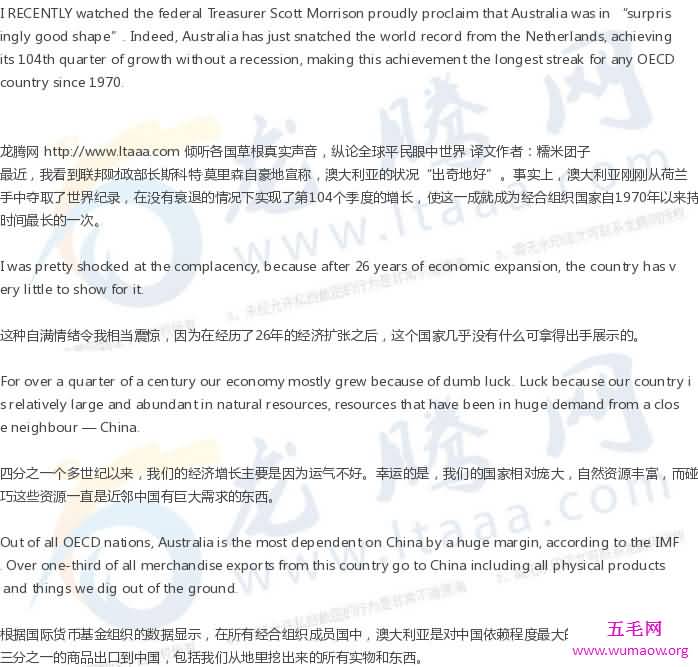
Outside of the OECD, Australia ranks just after the Democratic Republic of the Congo, Gambia and the Lao People’s Democratic Republic and just before the Central African Republic, Iran and Liberia. Does anything sound a bit funny about that?
在经合组织之外,澳大利亚排在刚果民主共和国、冈比亚和老挝人民民主共和国之后,仅次于中非共和国、伊朗和利比里亚。有发现什么听起来很可笑的东西吗?

As a whole, the Australian economy has grown through a property bubble inflating on top of a mining bubble, built on top of a commodities bubble, driven by a China bubble.
Unfortunately for Australia, that “lucky” free ride is just about to end.
总的来说,澳大利亚经济是在中国泡沫的推动下,在矿业泡沫和大宗商品泡沫的基础上,通过房地产泡沫的膨胀,实现的经济增长。不幸的是,澳大利亚的“幸运”免费搭车活动即将结束。
Societe Generale’s China economist Wei Yao recently said: “Chinese banks are looking down the barrel of a staggering $1.7 trillion worth of losses”. Hyaman Capital’s Kyle Bass calls China a “$34 trillion experiment” which is “exploding”, where Chinese bank losses “could exceed 400 per cent of the US banking losses incurred during the subprime crisis”.
法国兴业银行的中国经济学家姚伟(音译)最近表示:“中资银行正在看跌价值1.7万亿美元的巨额亏损。”海曼资本的凯尔·巴斯称中国是一个“34万亿美元的实验”,它正在“爆炸”,中国的银行亏损“可能超过美国在次贷危机期间遭受的银行损失的400%”。

Market turnover on the three Chinese exchanges jumped from a daily average of about $78 billion in February to a peak of $261 billion on April 22, 2016 — exceeding the GDP of Ireland. By comparison, Nasdaq’s daily turnover peaked in early 2000 at $150 billion.
三家中国交易所的市场成交额从2月份的每日平均约780亿美元跃升至2016年4月22日的峰值2610亿美元,超过了爱尔兰的国内生产总值(GDP)。相比之下,2000年初纳斯达克的日成交额也不过才达到1500亿美元。

While volume exploded, open interest didn’t. New contracts were not being created, volume instead was churning as the hot potato passed between speculators, most commonly in the night session, as consumers traded after work. So much so that sometimes analysts wondered whether the price of iron ore is set by the market tensions between iron ore miners and steel producers, or by Chinese taxi drivers trading on apps.
虽然成交量激增,未平仓合约数量不明。新合约尚未出台,但成交量反而在剧烈波动,因为投机者之间不停地传递烫手山芋,通常是在夜间交易中,因为消费者下班后进行交易。如此之多,以至于有时分析家想知道,铁矿石的价格波动是由铁矿石开采商和钢铁生产商之间的市场紧张局势决定的,还是因为中国出租车司机在应用软件上交易导致的。
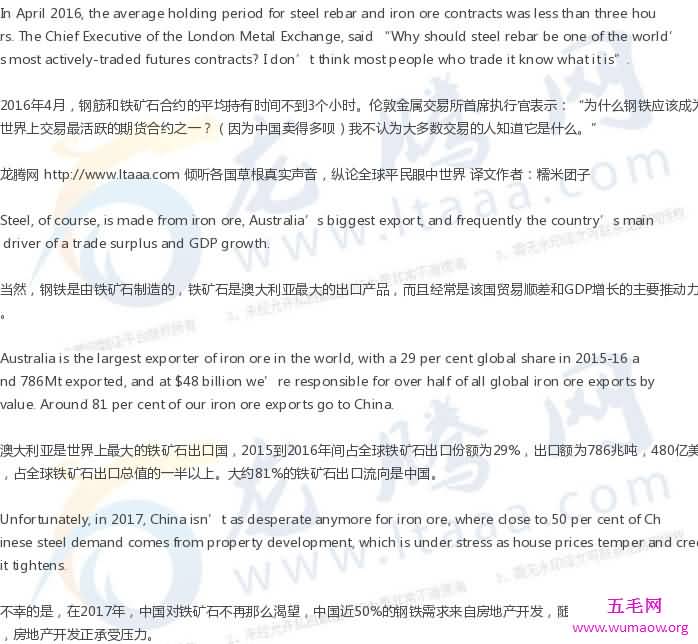
In May 2017, stockpiles at Chinese ports were at an all time high, with enough to build 13,000 Eiffel Towers. Last January, China pledged “supply-side reforms” for its steel and coal sectors to reduce excessive production capacity. In 2016, capacity was cut by six per cent for steel and eight per cent for coal.
2017年5月,中国港口的库存一直处于高位,足以建造13000座埃菲尔铁塔。去年一月,中国承诺为其钢铁和煤炭行业提供“供方改革”,以减少产能过剩。2016年,钢铁产能削减了百分之六,煤炭削减了百分之八。
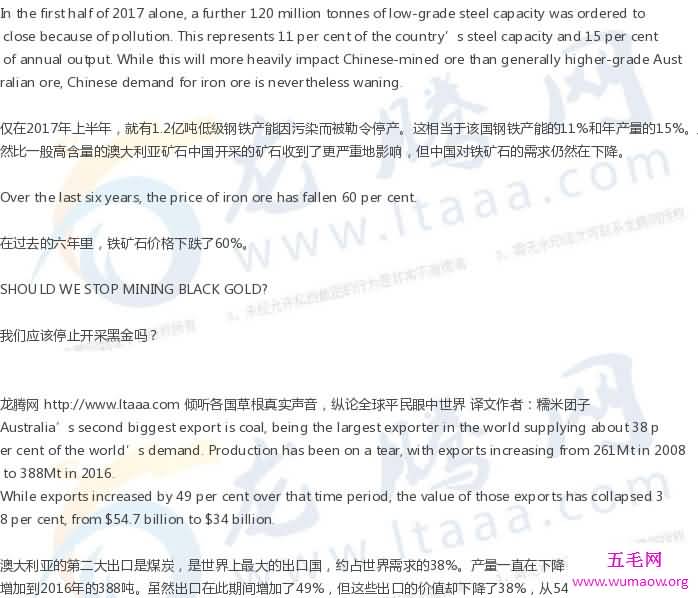
The only bright side for Australian coal in 2017 was that, unexpectedly, Cyclone Debbie wiped out several railroads and forced the closure of ports and mining operations, which has caused a temporary spike in coal prices.
2017年,澳大利亚煤炭的唯一亮点是,飓风黛比出乎意料地摧毁了几条铁路,并迫使港口和矿业关闭,导致煤炭价格暂时飙升。

Australia’s main export markets for coal are Japan and China, two markets in which the use of coal is forecast to decline through 2040.
澳大利亚的煤炭主要出口市场是日本和中国,其中煤炭的使用预计将在2040年下降。
Australia’s top export market for coal is Japan, and the unfortunate news is that the ramp up in coal exports here is a short lived adaptation after power companies idled their nuclear reactors in the wake of the Fukushima disaster. Between a zombie economy and fertility levels far below the replacement rate, Japan’s population is shrinking and thus naturally net electricity generation has also been declining in Japan since 2010.
澳大利亚的煤炭出口市场日本传来不幸的消息,在福岛灾难之后,电力公司暂停了他们的核反应堆,澳大利亚煤炭出口因此上升,这只是个短暂的适应时期。在僵尸经济与生育率远远低于更替率的水平之间,日本的人口正在萎缩,因此自2010年以来,日本的发电量也在下降。

According to the Australian Bureau of Statistics, in 2015-16 the entire Australian mining industry which includes coal, oil and gas, iron ore, the mining of metallic and non-metallic minerals and exploration and support services made a grand total of $179 billion in revenue.
根据澳大利亚统计局的数据,2015年至2016年间,澳大利亚的整个采矿业,包括煤炭、石油和天然气、铁矿石、金属和非金属矿产的开采以及勘探和支持服务,共创造了1790亿美元的收入。
It had $171 billion of costs and generated an operating profit before tax of $7 billion which representing a wafer thin 3.9 per cent margin on an operating basis.
该公司的成本为1710亿美元,税前营业利润为70亿美元,营业利润率为3.9%。
In the year before it made a 8.4 per cent margin.
前一年,该公司的利润率为8.4%。

In 2016, 67 per cent of Australia’s GDP growth came from the cities of Sydney and Melbourne where both state and federal governments have done everything they can to fuel a runaway housing market. The small area from the Sydney CBD to Macquarie Park is in the middle of an apartment building frenzy, alone contributing 24 per cent of the country’s entire GDP growth for 2016, according to SGS Economics & Planning.
2016年,澳大利亚国内生产总值增长的67%来自悉尼和墨尔本,这些城市的州政府和联邦政府都尽了一切努力来推动住房市场的失控。《SGS经济与规划》的数据显示,从悉尼CBD到麦格理公园的小块区域正处于一场公寓楼热潮之中,仅这一地区就贡献了2016年全国GDP增长的24%。
According to the Rider Levett Bucknall Crane Index, in the fourth quarter of 2017 between Sydney, Melbourne and Brisbane, there were now 586 cranes in operation, with a total of 685 across all capital cities, 80 per cent of which are focused on building apartments. There are 350 cranes in Sydney alone.
根据瑞德莱维特·布克纳尔·克雷恩指数的数据,2017年第四季度,悉尼、墨尔本和布里斯班之间有586台起重机在运行,在整个主要城市共有685台起重机,其中80%的起重机主要用于建造公寓。仅在悉尼就有350台起重机。
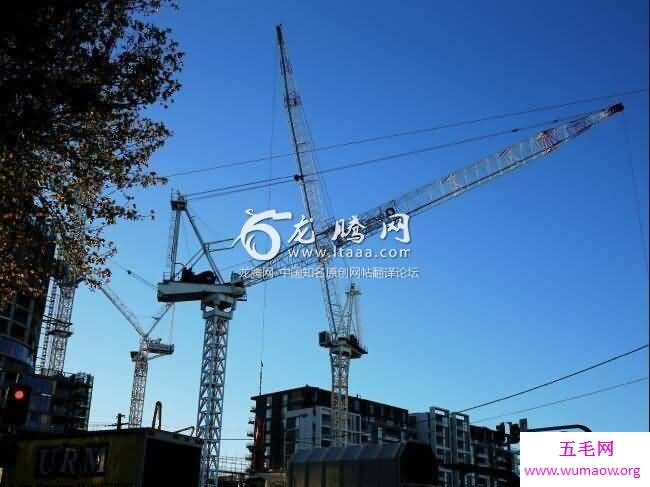
By comparison, there are currently 28 cranes in New York, 24 in San Francisco and 40 in Los Angeles.
相比之下,目前纽约有28台起重机,旧金山有24台,洛杉矶有40台。
According to UBS, around one third of these cranes in Australian cities are in postcodes with ‘restricted lending’, because the inhabitants have bad credit ratings.
据瑞银称,在澳大利亚城市,这些起重机中约有三分之一采用了“限制放贷”的邮政编码,因为当地居民的信用评级很差。
This can only be described as completely “insane”.
这只能说是完全“疯狂”的。
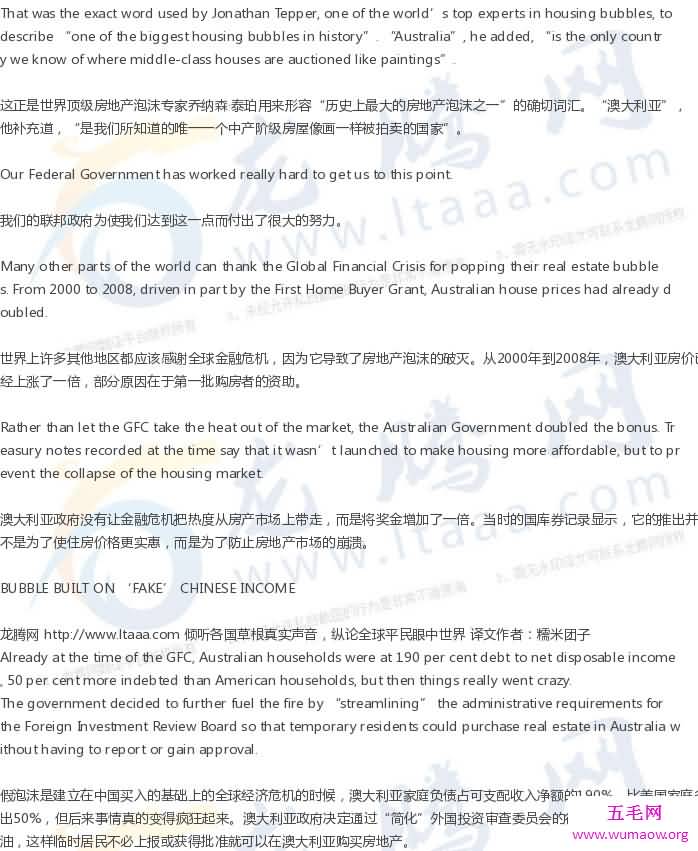
It may be a stretch, but one could possibly argue that this move was cunningly calculated, as what could possibly be wrong in selling overpriced Australian houses to the Chinese?
这可能有点牵强,但人们可能会辩称,这一举措是经过巧妙计算的,向中国人出售价格过高的澳大利亚房屋会出什么问题呢?
I am not sure who is getting the last laugh here, because as we subsequently found out, many of those Chinese borrowed the money to buy these houses from Australian banks, using fake statements of foreign income. Indeed, according to the AFR, this was not sophisticated documentation — Australian banks were being tricked with photoshopped bank statements that can be bought online for as little as $20.
我不确定谁会在这里笑到最后,因为正如我们随后发现的,许多中国人借钱从澳大利亚银行购买这些房子,使用虚假的外国收入报表。事实上,根据AFR的说法,这不是什么复杂的文件——澳大利亚银行被网上购买的银行报表欺骗,网上购买这个报表只需要20美元。
UBS estimates that $500 billion worth of “not completely factually accurate” mortgages now sit on major bank balance sheets. How much of that will go sour is anyone’s guess.
瑞银估计,主要的银行资产负债表上有价值5000亿美元的“不完全准确”的抵押贷款存在,这其中有多少会变成坏账,谁也猜不出来。
WE CAN’T AFFORD TO LIVE HERE
Foreign buying driving up housing prices has been a major factor in Australian housing affordability, or rather unaffordability.
我们不能住在这里外国购房推高房价一直是澳大利亚房价承受能力的一个主要因素,或者说是无法承受的因素。
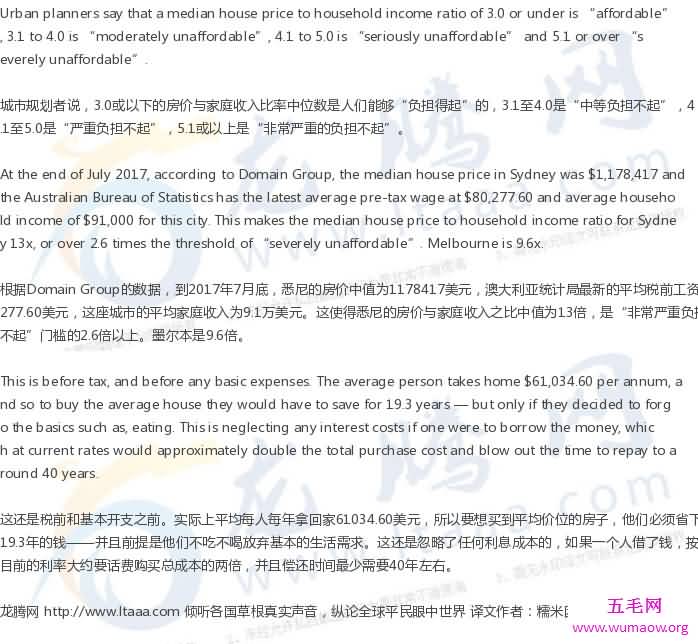
Unsurprisingly, the CEOs of the Big Four banks in Australia think that these prices are “justified by the fundamentals”. More likely because the Big Four, who issue over 80 per cent of residential mortgages in the country, are more exposed as a percentage of loans than any other banks in the world, over double that of the US and triple that of the UK, and remarkably quadruple that of Hong Kong, which is the least affordable place in the world for real estate. Today, over 60 per cent of the Australian bank loan books are residential mortgages. Houston, we have a problem.
意料之中的是,澳大利亚四大银行的首席执行官们认为,这些价格“从基本面来看是合理的”。在全国发行超过80%的住房抵押贷款的四大银行,其贷款比例比世界上任何其他银行都要高,是美国的两倍,是英国的三倍,是香港的四倍。香港是世界上最昂贵的房地产市场。如今,澳大利亚60%以上的银行贷款都是住宅抵押贷款。休斯顿,我们有问题了。

WE’VE BEEN HERE BEFORE, LONG BEFOREAustralia is not alone, Chinese “hot money” is blowing gigantic property bubbles in many other safe havens around the world.But combined with our lack of future proof industries and exports, our economy is completely stuffed. And it’s only going to get worse unless we make a major transformation of the Australian economy.We can’t rely on property to provide for our future. In 1880, Melbourne was the richest city in the world, until it had a property crash in 1891 when house prices halved causing Australia’s real GDP to crash by 10 per cent in 1892 and seven per cent the year after.The depression caused by this crash was substantially deeper and more prolonged than the Great Depression of the 1930s. Macro Business points out that if you bought a house at the top of the market in 1890s, it took 70 years for you to break even again.Instead of relying on a property bubble as pretence that our economy is strong, we need serious structural change to the composition of GDP that’s substantially more sophisticated in terms of the industries that contribute to it.Australia’s GDP of $1.6 trillion is 69 per cent services. Our “economic miracle” of GDP growth comes from digging rocks out of the ground, shipping the by-products of dead fossils, and stuff we grow. Mining, which used to be 19 per cent, is now seven per cent and falling.Combined, the three industries now contribute just 12 per cent of GDP thanks to the global collapse in commodities prices.If you look at businesses as a whole, Company tax hasn’t moved from $68 billion in the last three years — our companies are not making more profits. This country is sick.
我们很久以前就在这里澳大利亚并非孤军奋战,中国的“热钱”在全球许多其他安全避风港掀起了巨大的房地产泡沫。但结合我们缺乏未来的工业和出口,我们的经济是完全填塞起来的。除非我们对澳大利亚经济进行重大改革,否则情况将变得更糟。我们不能靠财产来维持我们的未来。1880年,墨尔本是世界上最富有的城市,直到1891年房地产崩盘,当时房价下跌了一半,导致澳大利亚实际GDP在1892年下跌了10%,次年下跌了7%。这次崩盘所造成的影响比上世纪30年代的大萧条要深远得多,时间也更长。宏观商业指出,如果你在19世纪90年代在市场顶端买了一套房子,你需要70年才能再次实现收支平衡。我们不需要以房地产泡沫为借口,假装我们的经济很强劲,而是需要对GDP构成进行严重的结构性改革,而这种结构在对GDP贡献更大的行业方面要复杂得多。澳大利亚1.6万亿美元的国内生产总值是69%的服务业。我们GDP增长的“经济奇迹”来自于从地下挖出的矿石,运送死掉的化石的副产品,以及我们种植的东西。过去采矿业占据GDP的19%,现在为7%,而且还在下降中。由于全球大宗商品价格暴跌,这三个行业目前仅占GDP的12%。从整体来看,公司税从过去三年的680亿美元没有再上涨过,我们的公司没有获得更多的利润。这个国家病了。
CAN WE FIX IT?We have serious problems in this country. And I think they are about to become very serious. We are on the wrong trajectory.I’ll leave you now with one final thought.Harvard University created something called the Economic Complexity Index. This measure ranks countries based upon their economic diversity — how many different products a country can produce — and economic ubiquity — how many countries are able to make those products.Where does Australia rank on the global scale?Worse than Mauritius, Macedonia, Oman, Moldova, Vietnam, Egypt and Botswana. Worse than Georgia, Kuwait, Colombia, Saudi Arabia, Lebanon and El Salvador.Sitting embarrassingly and awkwardly between Kazakhstan and Jamaica, and worse than the Dominican Republic at 74 and Guatemala at 75, Australia ranks off the deep end of the scale at 77th place.77th and falling. After Tajikistan, Australia had the fourth highest loss in Economic Complexity over the last decade, falling 18 places.Thirty years ago, a time when our Economic Complexity ranked substantially higher, these words rocked the nation: “We took the view in the 1970s — it’s the old cargo cult mentality of Australia that she’ll be right.“This is the lucky country, we can dig up another mound of rock and someone will buy it from us, or we can sell a bit of wheat and bit of wool and we will just sort of muddle through.“In the 1970s … we became a third world economy selling raw materials and food and we let the sophisticated industrial side fall apart … If in the final analysis Australia is so undisciplined, so disinterested in its salvation and its economic well being, that it doesn’t deal with these fundamental problems … Then you are gone. You are a banana republic.”Looks like Paul Keating was right.The national conversation needs to change, now.
我们能够治好它么?我们在这个国家有严重的问题。我认为他们会变得非常严重。我们走错轨道了。我现在的想法是我们要离开这个轨道。哈佛大学创造了一个叫做经济复杂性指数的东西。这一衡量标准根据各国的经济多样性-一个国家可以生产多少种不同的产品-以及经济上的普遍性-以及有多少国家能够生产这些产品-对它们进行排名。澳大利亚在全球范围内排名如何?比毛里求斯、马其顿、阿曼、摩尔多瓦、越南、埃及和博茨瓦纳还要糟糕。比格鲁吉亚、科威特、哥伦比亚、沙特阿拉伯、黎巴嫩和萨尔瓦多还要差劲。难看而尴尬地夹在哈萨克斯坦和牙买加之间,比排名74的多米尼加共和国和排名75的危地马拉更糟糕,澳大利亚排名第77位。77的位置也不一定能保住。继塔吉克斯坦之后,澳大利亚在过去十年中经济损失的损失率是第四,导致我们下降了18位。30年前,当我们的经济复杂性指数大大提高的时候,这句话震撼了整个国家:我们在20世纪70年代就采取了这种观点——澳大利亚的旧货崇拜心态认为她会是对的。这是一个幸运的国家,我们可以挖出另外一堆石头(矿石),有人会从我们这里买下它,或者我们可以拿出一小部分小麦和羊毛来卖,就能够勉强糊口了。“在20世纪70年代,我们成为出售原材料和食品的世界第三大经济体后,我们让先进的工业部门分崩离析了……如果归根结底,澳大利亚是如此不守纪律,对其国家拯救和经济福祉毫无兴趣,也不愿意去处理这些根本问题…那就这样吧。你们就是一个香蕉共和国。”看来保罗·基廷是对的。现在全国对话需要改变。
![澳大利亚网站称中国确认禁止从澳大利亚进口煤炭(上)(已证实是假消息) [澳大利亚媒体]](https://pic.wumaow.org/d/file/p/suoluetu/1551404821925.jpg)
澳大利亚网站称中国确认禁止从澳大利亚进口煤炭(上)(已证实是假消息) [澳大利亚媒体]
世界排行
2019-03-01![澳大利亚网站称中国确认禁止从澳大利亚进口煤炭(下)(已证实是假消息) [澳大利亚媒体]](https://pic.wumaow.org/d/file/p/suoluetu/1551404821925.jpg)
澳大利亚网站称中国确认禁止从澳大利亚进口煤炭(下)(已证实是假消息) [澳大利亚媒体]
世界排行
2019-03-01![澳大利亚取消了中国亿万富翁的居留权 [澳大利亚媒体]](https://pic.wumaow.org/d/file/p/suoluetu/1549855705711.jpg)
澳大利亚取消了中国亿万富翁的居留权 [澳大利亚媒体]
世界排行
2019-02-11![想要搭上中国的发展浪潮已经太晚了,然而另一个巨大的机会正向我们展现希望。 [澳大利亚媒体]](https://pic.wumaow.org/d/file/p/suoluetu/1543647638994.jpg)
想要搭上中国的发展浪潮已经太晚了,然而另一个巨大的机会正向我们展现希望。 [澳大利亚媒体]
世界排行
2018-12-01![中国警察通缉史上最美的女逃犯 [澳大利亚媒体]](https://pic.wumaow.org/d/file/p/suoluetu/1543375497826.jpg)
中国警察通缉史上最美的女逃犯 [澳大利亚媒体]
世界排行
2018-11-28![惨烈车祸司机保释遭拒,华裔夫痛失澳洲孕妻 [无评论] [澳大利亚媒体]](https://pic.wumaow.org/d/file/p/suoluetu/1543197413341.jpg)
惨烈车祸司机保释遭拒,华裔夫痛失澳洲孕妻 [无评论] [澳大利亚媒体]
世界排行
2018-11-26![澳大利亚:我们的整个经济体系建立在中国购买我们的东西上 [澳大利亚媒体]](https://pic.wumaow.org/d/file/p/suoluetu/1539854957958.jpg)
澳大利亚:我们的整个经济体系建立在中国购买我们的东西上 [澳大利亚媒体]
世界排行
2018-10-19![澳媒:中国代表团在太平洋岛国论坛对瑙鲁主办方暴怒离席 [澳大利亚媒体]](https://pic.wumaow.org/d/file/p/suoluetu/1536368375979.jpg)
澳媒:中国代表团在太平洋岛国论坛对瑙鲁主办方暴怒离席 [澳大利亚媒体]
世界排行
2018-09-08![“你不会紧张的”:皇家海军潜水员在搜寻未爆炸的二战炸弹 [澳大利亚媒体]](https://pic.wumaow.org/d/file/p/suoluetu/1533885441823.jpg)
“你不会紧张的”:皇家海军潜水员在搜寻未爆炸的二战炸弹 [澳大利亚媒体]
世界排行
2018-08-10![奥萨马·本·拉登的妈妈说他是个“好孩子”,这个基地组织领导人是在上大学时变激进的 [澳大利亚媒体]](https://pic.wumaow.org/d/file/p/suoluetu/1533520106714.jpg)
奥萨马·本·拉登的妈妈说他是个“好孩子”,这个基地组织领导人是在上大学时变激进的 [澳大利亚媒体]
世界排行
2018-08-06
热门文章推荐
![澳大利亚:我们的整个经济体系建立在中国购买我们的东西上 [澳大利亚媒体]](https://pic.wumaow.org/d/file/p/suoluetu/1539854957958.jpg)
澳大利亚:我们的整个经济体系建立在中国购买我们的东西上 [澳大利亚媒体]
![澳媒:中国代表团在太平洋岛国论坛对瑙鲁主办方暴怒离席 [澳大利亚媒体]](https://pic.wumaow.org/d/file/p/suoluetu/1536368375979.jpg)
澳媒:中国代表团在太平洋岛国论坛对瑙鲁主办方暴怒离席 [澳大利亚媒体]
![“你不会紧张的”:皇家海军潜水员在搜寻未爆炸的二战炸弹 [澳大利亚媒体]](https://pic.wumaow.org/d/file/p/suoluetu/1533885441823.jpg)
“你不会紧张的”:皇家海军潜水员在搜寻未爆炸的二战炸弹 [澳大利亚媒体]
![对女性最危险的十大国家排名中印度夺冠,美国上榜? [澳大利亚媒体]](https://pic.wumaow.org/d/file/p/suoluetu/1530493025651.jpg)
对女性最危险的十大国家排名中印度夺冠,美国上榜? [澳大利亚媒体]
![“帝国如何兴起。”中国已经开始了全球行动,而这是澳大利亚的回应。 [澳大利亚媒体]](https://pic.wumaow.org/d/file/p/suoluetu/1530237607434.jpg)
“帝国如何兴起。”中国已经开始了全球行动,而这是澳大利亚的回应。 [澳大利亚媒体]

世界三大舰队,他们的海上作战实力如何,是否可以制霸海域

世界四大乐队,当年红极一时的Beyond是否名列其中呢

世界三大牛仔裤品牌,为你解读世界排名前三的牛仔裤
阅读TOP10
- 1 澳大利亚网站称中国确认禁止从澳大利亚进口煤炭(下)(已证实是假消息) [澳大利亚媒体]
- 2 中国警察通缉史上最美的女逃犯 [澳大利亚媒体]
- 3 澳媒:中国代表团在太平洋岛国论坛对瑙鲁主办方暴怒离席 [澳大利亚媒体]
- 4 澳大利亚正站在对抗中国的最前线,班农表示。 [澳大利亚媒体]
- 5 对女性最危险的十大国家排名中印度夺冠,美国上榜? [澳大利亚媒体]
- 6 世界石油储量最多的国家竟然是这个 我要去土豪国要饭了
- 7 火影忍者里的自来也第几集死的 死后又发生了什么事情
- 8 好声音戴荃悟空歌词,唱出西游中悟空的叛逆
- 9 最有名的国际四大会计师事务所 你知道吗
- 10 真心羡慕世界石油储量排行中的国家 妥妥的土豪国
- 11 时代周刊――一本享誉中外的新闻杂志
- 12 世界上最毒的毒蜘蛛有哪几种 毒液可以毒到什么程度
- 13 十款最省油的轿车推荐给计划购车的您
- 14 看世界经济排名,我国不久将超越美国成世界第一!
- 15 几千年来,全球首富中国几人榜上有名?